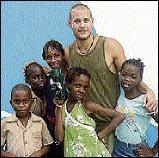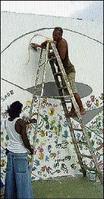Paul H. Williams, Sunday Gleaner Writer
Graffiti produced by Julian Vogel, a German graphic artist. - Photos by Paul Williams
Julian Vogel has travelled a long way from home in Berlin, Germany, with a singular mission of peace. The 26-year-old, a trained graphic artist, has been to several war-torn countries and communities, using his talents to paint 'peace walls', which are in stark contrast to the infamous and now partially destroyed Berlin Wall, once the world's greatest symbol of oppression and divisiveness.
Seemingly motivated by his country's long history of wars, Vogel was recently in Jamaica painting his message of "peace and freedom" on Windward Road, east Kingston.

Vogel poses with some children.
"The idea for world peace walls was born during my spontaneous trip to Iraq. Having realised under which difficult conditions people in Kurdistan are living and which poor perspective people have, I wanted to use my means to give a small ray of hope to peace in this country," he says. His first graffiti, "with a peace and freedom message", was done on parts of a wall that surrounds one of Saddam Hussein's palaces.
The next stop was Bihar, India. Then on to Jamaica. It was not surprising that east Kingston was chosen as one of the stops on Vogel's peace-promoting crusades.
There's another way
"Kingston is one of the places all over the world with the highest crime rate, the highest killing rate, and I think that such a place like Kingston is a good place to do a peace wall to show the people that there's another way," he told The Sunday Gleaner.
The site identified and selected was the eastern Peace Centre. Over a two-day period in November, with assistance from members of Grupo Cativeiro Capoeiro, students of a prep school on the compound, and a few children from the community, the project was completed on November 7. It is now a permanent reminder of the hope that peace can bring.

Vogel at work.
Though each mural has a different treatment, there is a motif that is common to all - the dove carrying an olive branch. Then there is the flag, and a characteristic significant slogan in the respective country's official language. "The general theme itself relates to the culture, traditional art, symbols, history and people of the host country," he said.
On the Jamaican version, the national motto, the Jamaican flag and some hibiscuses are very prominent. It is dominated by the palmprints and sketches of students and community children who participated in the project.
But why graffiti, and not some other mainstream medium?
"I have chosen the medium, graffiti, as it can be easily assimilated in everyday life, and is obvious in the message for the respective cultures ... I would like to demonstrate that graffiti can definitely be a constructive medium. With these pictures, I would like to raise the awareness of peace, harmony and aesthetics, and remind people that everyone can contribute to a more peaceful world, no matter which culture one belongs to," Vogel explained.
Vogel has long left for another project and the impact of his work is yet to be seen. Yet, failure or success is secondary to the noble gesture of a young man who is a harbinger of peace on a planet embroiled in warfare.
paul.williams@gleanerjm.com

